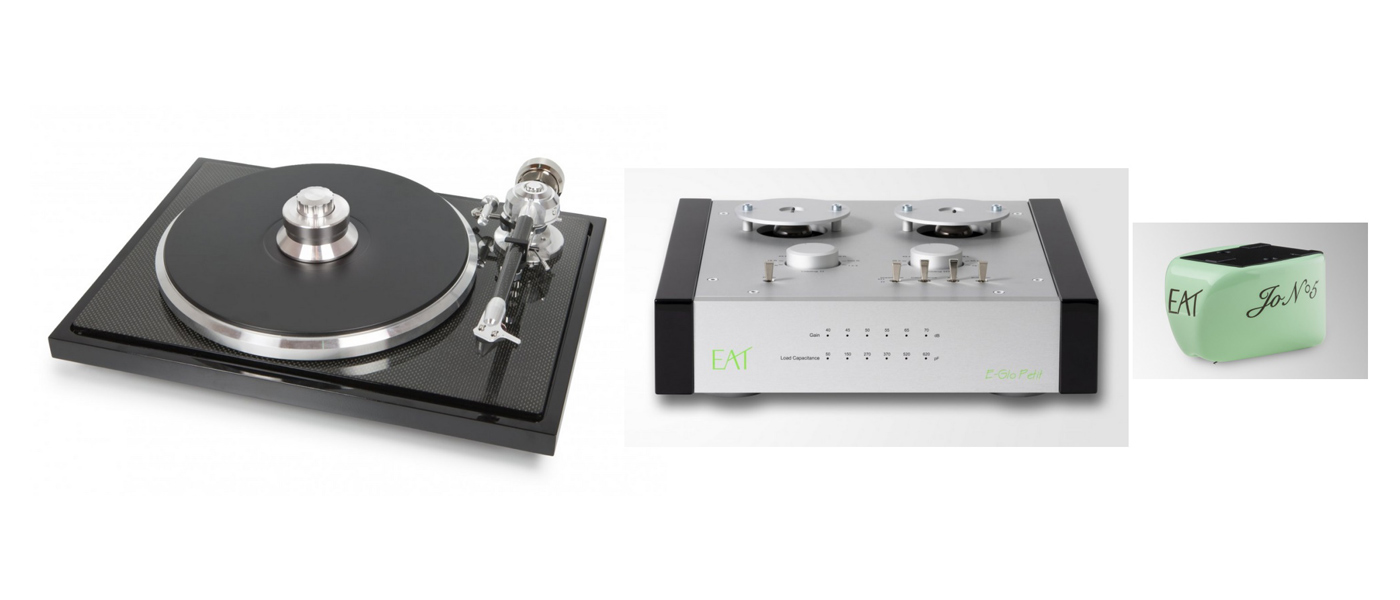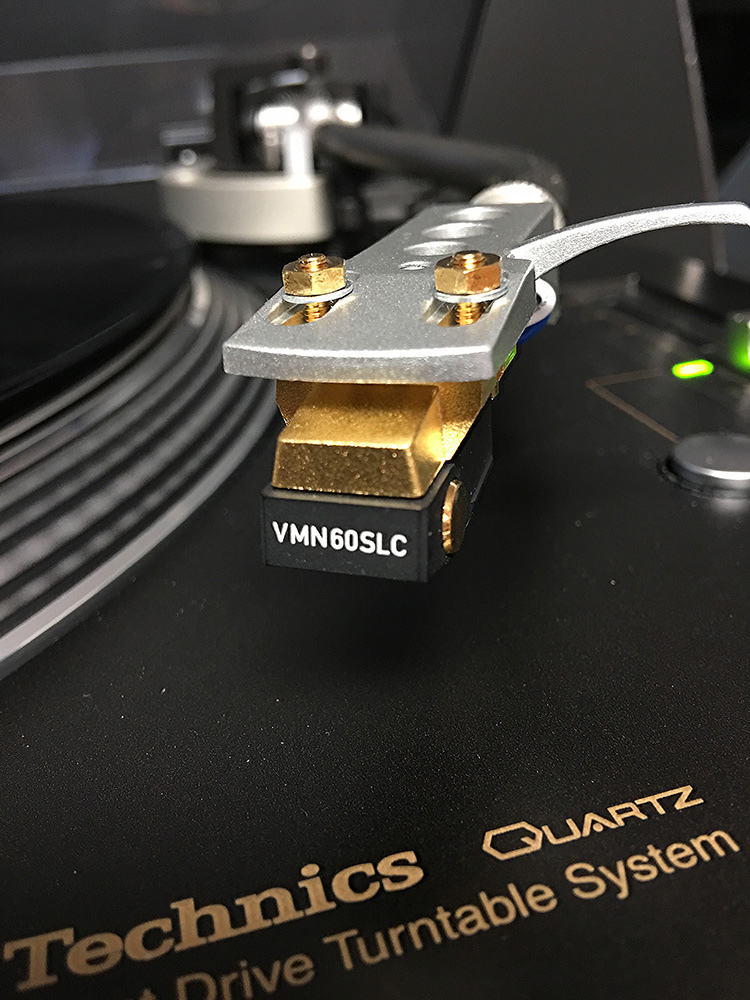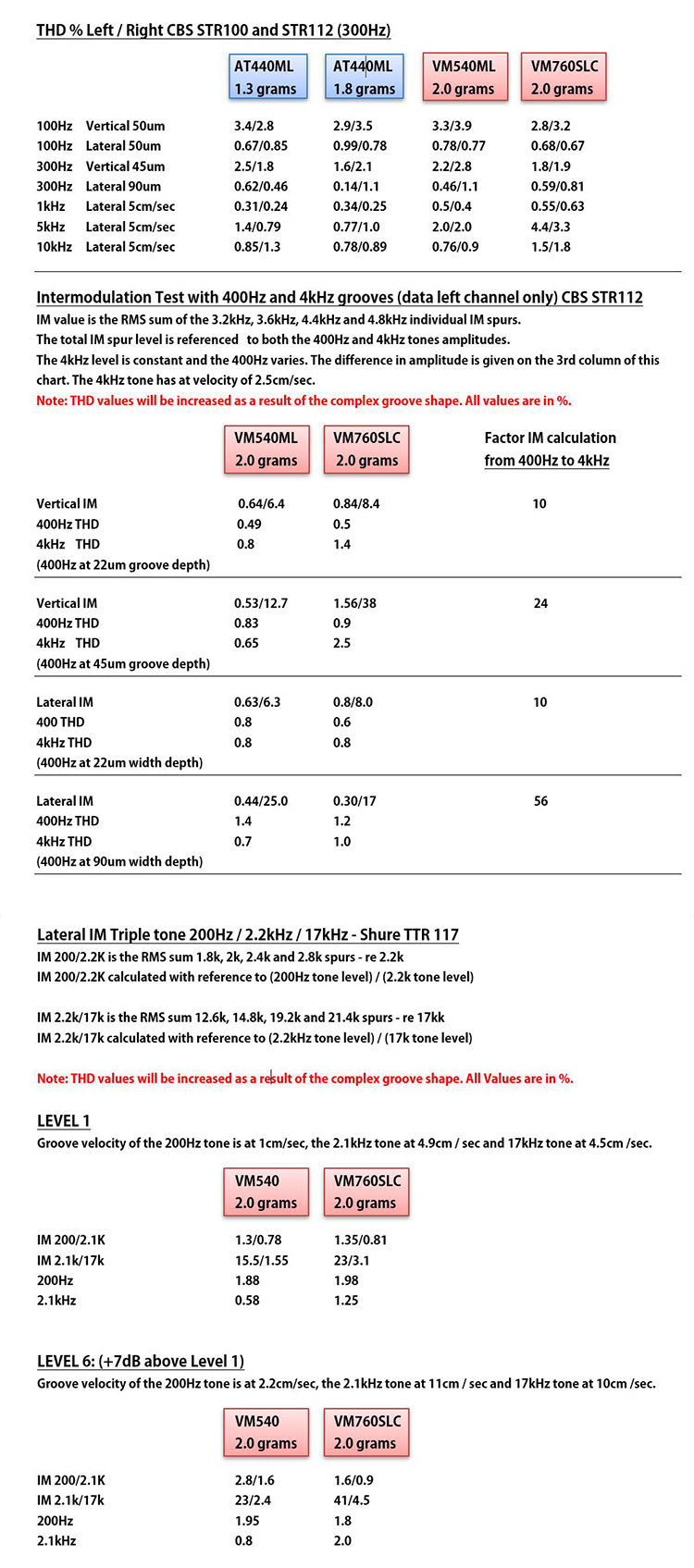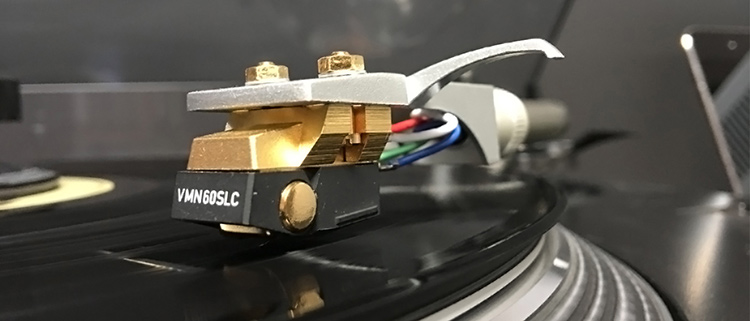
This approach grants a certain amount of flexibility should someone say, wish to try out the MicroLine or the Shibata stylus of the VM540ML or the VM750SH respectively. The VM760SLC has a mildly boosted upper-end response, so careful matching with your electronics and speakers are is recommended to get the best results from this cartridge.
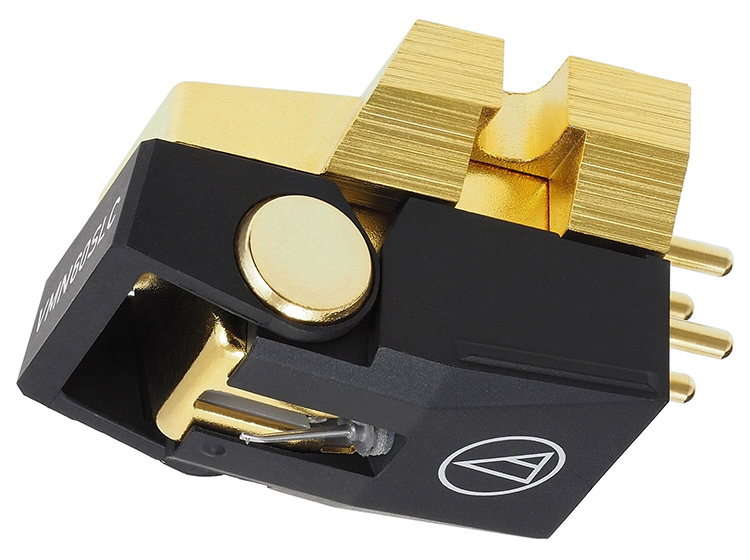
Audio-Technica VM760SLC ¾ view
Audio-Technica VM760SLC Phono Cartridge Highlights
- Very good sound quality overall.
- Bass and midrange are well balanced and clean sounding.
- Boosted treble can sound harsh with certain speakers. Careful system matching is advised.
- Decent tracking ability.
- Good build quality.
Audio-Technica began life in 1962, being established and headquartered in Tokyo, Japan. While its current product portfolio is full of all manner of consumer audio and broadcast items, Audio-Technica (AT) originally got its start producing solely phono cartridges for the Japanese home market. By 1969, AT had produced a number of successful cartridge and tonearm designs, including the development of their proprietary VM dual magnet phono cartridge, and soon it began exporting these products abroad.
In the ensuing years, Audio-Technica has branched out into a number of other product categories finding success and acclaim particularly with its headphones and broadcast microphone expertise. And yet, 55 years later, AT has not forgotten its roots and is still producing a broad array of both moving magnet and moving coil phono cartridges.
Audio-Technica introduced their cartridges to the US market in the 1970s. Some well-reviewed examples of AT cartridges in the US include the AT25, AT-160ML, AT-ML170, AT440MLa (and b) and the AT-OC9ML/II. The VM760SLC that we have here is the top model in Audio Technica’s 700 series of moving magnet cartridges. At an MSRP of $649.00, it represents (these days) a moderate but still serious investment to make in your vinyl playback chain. Is it worth it? Let us see…
Design:
Moving Magnet Phono Cartridge featuring a proprietary dual-magnet VM design
Stylus Tip:
1.5 x 0.28 mil Nude Special Line Contact Diamond tip mounted on a tapered aluminum cantilever
Replacement Stylus:
VMN60SLC
Stereo Output:
4 mV @ 1 kHz
Frequency Response (Manufacturer):
20 Hz – 30 kHz
Channel Separation (Manufacturer):
30 dB @ 1kHz
Recommended Tracking Force:
1.8 – 2.2 grams (2.0 grams standard)
Recommended Resistance Loading:
47 kOhms
Recommended Capacitance Loading:
100-200 picofarads/channel (includes tonearm wiring and phono preamp input capacitance).
Cartridge Height:
17.3 mm
Weight:
8.0 grams
Accessories:
Installation screws and washers, screwdriver, cleaning brush and lead wire set
MSRP:
$649.00
Company:
SECRETS Tags:
Audio-Technica, VM760SLC, Phono, Cartridge, Audiophile, Moving Magnet, Dual-Magnet, MicroLine, Phono Cartridge Reviews 2018

Description of stylus types
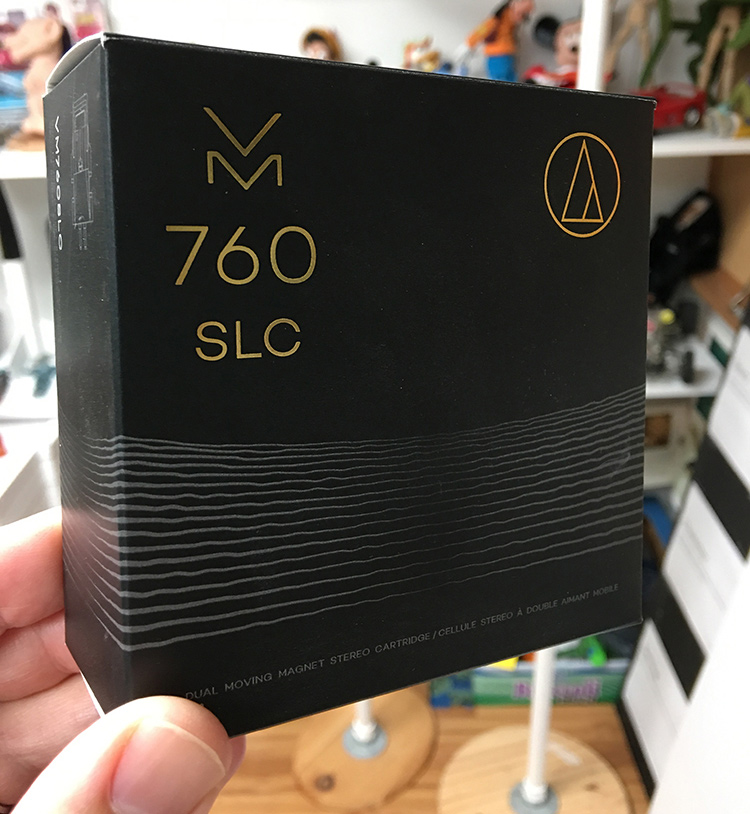
VM760SLC Packaging
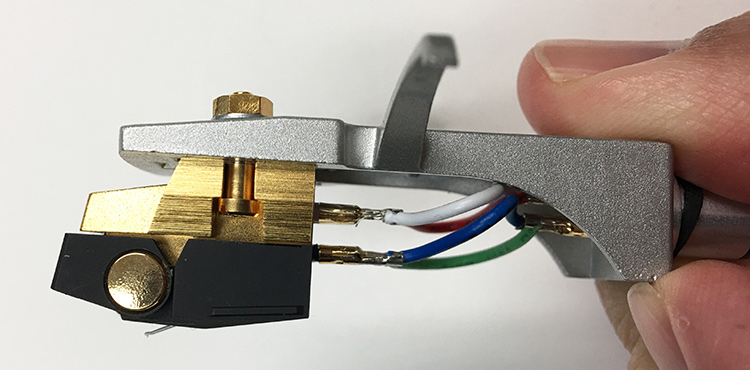
VM760SLC mounted on Head Shell side view
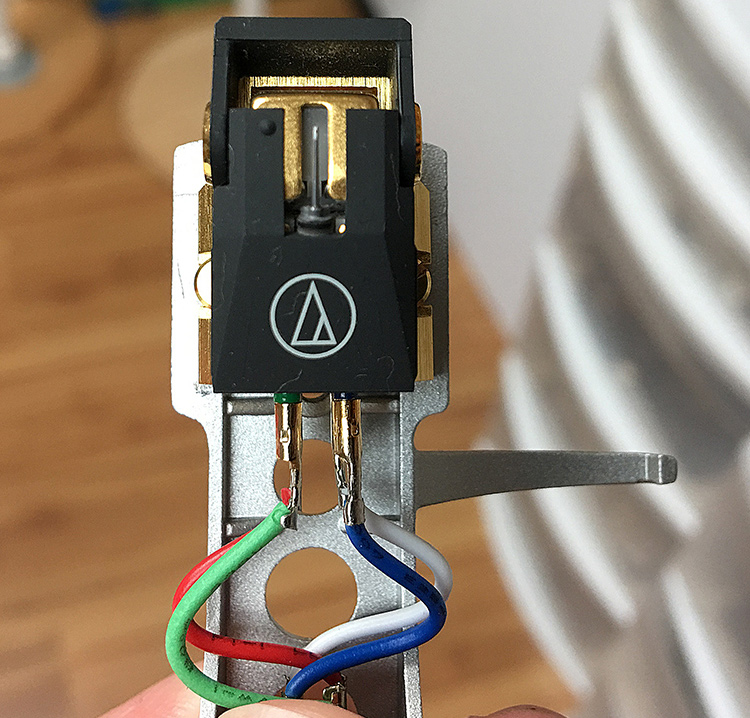
VM760SLC mounted on Head Shell bottom view
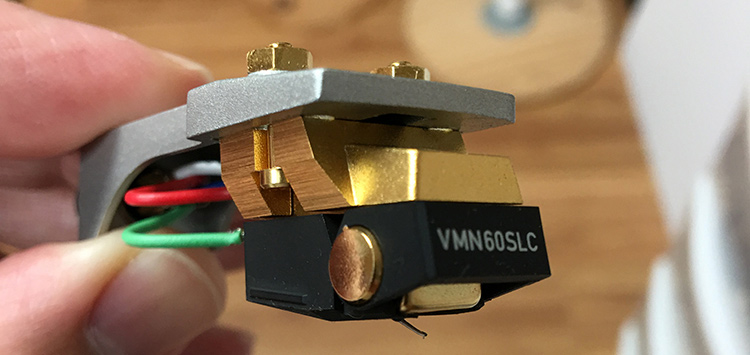
VM540ML mounted on Head Shell front view
The Audio-Technica VM760SLC is a moving magnet type phono cartridge and is the most expensive of the three models found in AT’s 700 series line of cartridges. All the carts in this series feature essentially the same body shell design but are differentiated by varying types of styli. The styli are easily interchangeable and one could conceivably convert a VM760SLC to any of the other three models in the line with a simple change of the replacement stylus, should you prefer the sound of a different tip. This philosophy also applies to Audio-Technica’s, midrange, 500 series as well. The construction of the VM760SLC is based off of AT’s proprietary, VM dual magnet architecture. In place of a single magnet, the VM cartridge design makes use of twin magnets (one per channel) arranged in a “V” pattern. The VM760SLC also features a nude diamond Special Line Contact stylus tip mounted to a tapered aluminum canteliever. The cartridge housing itself is made of a gold-colored aluminum-alloy which is said to “minimize vibrations and act as a natural electrical shield”. The VM760SLC comes packaged with installation hardware, a non-magnetic screwdriver, cleaning brush and a replacement lead wire set.
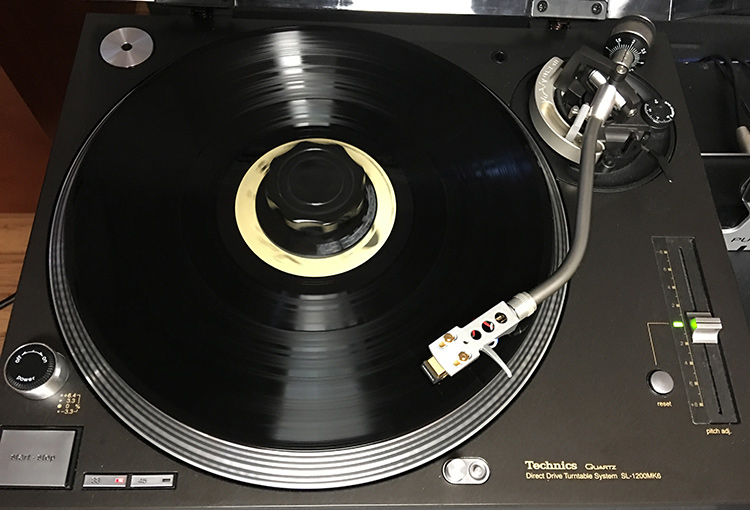
VM760SLC Test Setup
For this review, the connected components consisted of: Technics SL1200 Mk 6 turntable with a KAB fluid dampened tonearm mod and a custom power supply, a PASS Labs XP-25 phono preamp, a Rotel RQ-970BX phono preamp, a Bryston BP-25 line-level preamp, a Marchand XM-44 2-way active crossover, a Marchand BASSIS parametric EQ, two Class D Audio SDS-470C power amplifiers (300 watts @ 8 ohm, 600 watts @ 4 ohm) and a Panamax M5500 power conditioner. My speakers are Bamberg Engineering Sound Labs Series 2 Monitors and a pair of sealed DIY 15-inch subwoofers. I also used the Paradigm Persona 7F speakers while they were in for review. Speaker wire and interconnect cable are from Blue Jeans Cable.
Secrets Sponsor
The Audio-Technica VM760SLC was installed in an OEM Technics SL1200 head shell and was mounted using the Technics Overhang Gauge and aligned using a Shure alignment guide. Tracking force was set using a digital tracking force scale and anti-skate was set with the aid of the anti-skate band track of the Shure “Audio Obstacle Course” LP (TTR-117). Tracking force was set to the optimum level as recommended by the manufacturer, in this case 2.0 grams.
Immediate first impressions upon opening the shipping box and examining the contents are that the VM760SLC arrives nicely packaged and seems well put together. From a build quality standpoint, the aluminum-alloy construction of the cartridge is of a high standard. The act of stylus replacement seems relatively straightforward as it’s recommended to remove the stylus when you initially install the cartridge body onto the headshell. Upon re-installation, the stylus snaps back into the body in a reassuring manner. The cartridge otherwise presented no undue or particularly finicky installation issues.
Sonically, it became apparent after listening to a number of familiar tracks, the VM760SLC has a modestly “hotter” top end than the previously reviewed Audio-Technica VM540ML. It also has a noticeably less euphonic and more straightforward sonic presentation than it’s lower-priced stablemate. Bass and midrange were well represented and sounded just as good as the VM540ML, albeit with a slightly more narrow soundstage if you will.
I’ve had this cartridge for a while and subsequently cycled through a few different pairs of speakers with it. To my ears it sounded at it’s best when mated with speakers that have a certain level of upper treble roll off than it did with speakers that posses extended upper end response. As such, the VM760SLC sounded more appealing to me with my standard Bamberg/dual subwoofer speaker setup than it did with the Paradigm Persona 7F for example. This cartridge was, most likely, intentionally voiced this way for whatever reason and a large part of selecting the right phono cartridge has to do with personal taste and listening material. That being said, when using the Personas, I felt that the treble quality of this cartridge, in a number of instances, sounded slightly etched for my tastes and I began to find it a little fatiguing. Listening to the same material with the Bamberg/subwoofer combination or even my original Salk Songtowers, the treble was much smoother sounding and more appealing. The Salks actually brought a little more zing to the top end than the Bambergs did, but not so much as to be objectionable. As I mentioned earlier, bass and midrange quality gave me nothing to complain about. Plenty of detail retrieval in both areas. Bass was tight and punchy sounding with all manner of drums, and vocals and piano had a great sense of presence and immediacy but not quite so much size and spread.
Out of curiosity, I carefully swapped out the Special Line Contact stylus of this cartridge and put in the MicroLine stylus of the VM540ML, effectively creating a VM740ML. This is exactly what the whole modular idea of Audio-Technica’s VM line is all about. Allowing customers a certain level of upgradability and/or tuning to taste. With this combination I felt that some added dimension returned to the music. A bigger soundstage, a smoother sounding top end and, if my musical memory is to be believed, a little more detail retrieval in the midrange. This last point was most particularly noticed on more intimate vocal selections. I don’t, however, think that the newly minted VM740ML brought anything more to the table than what the VM540ML already serves.
So, what does all this mean? It means know your gear, your room and your listening habits. If you have speakers with entended frequency response, perhaps using metal domes or ribbons for tweeters, and your room allows them to be fully exploited, you may not find this cartridge to be to your liking. If your speakers have a less aggressive or not-quite-ruler flat top end, maybe using soft dome tweeters, then the VM760SLC could be a more agreeable match. It also helps if you know that your speakers have a big sweet-spot or throw out a wide image. A tube based phono preamp might also be a good match for this cart too. At least that would be my honest advice when considering the VM760SLC. It can sound really good in the right circumstances but careful system integration is in order.
As I have mentioned in previous phono cartridge reviews, I wish this cartridge would be outfitted with a dynamic stabilizer brush like the Shure M97xE has. A damped brush of this type, designed for the cartridge, works as good as having a damped tonearm in reducing low resonant frequencies excited by the cartridge/tonearm combination. It should be standard issue on phono cartridges of this price.
Some of the more memorable music selections that I experienced with the Audio-Technica VM760SLC:
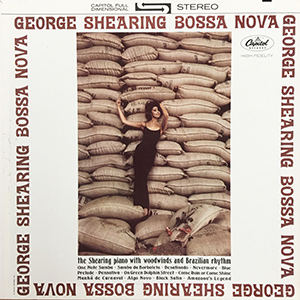
I realize that some people may be tempted to consider this akin to listening to elevator music, but I find it to be soothing and great stuff to relax to. This is good since most of these songs have had their intensity lowered to be just that, more gentle, rhythmic and chill.
George Shearing’s piano work is melodic and tasteful throughout. The VM760SLC does shine with a well recorded piano and this is no exception. The piano in “One Note Samba” has a full sound with a nice clean ring and decay to the notes. The acoustic bass had meaty and thick sounding notes after each finger pluck. Detail retrieval was admirable on songs like “Samba Da Borboleta” where you could clearly hear all the subtleties of the “beans” in the maracas quickly being shaken in each channel. The woodwind section that plays on much of this album had great timbre and richness to its sound. Thankfully, the VM760SLC did not make them sound overly edgy or coarse and the flutes played gently enough as to not get objectionable either. Soundstage, overall, was a little more constrained than I am used to on this album.
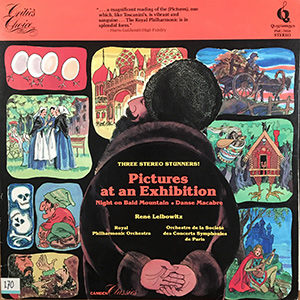
Here we have three powerful orchestral works: A Night on Bald Mountain, Pictures at an Exhibition, and Danse Macabre presented on one album. The performances were recorded in 1960 and 1964 respectively and yet they all sound quite clear and vibrant for their vintage.
Orchestre De La Societe Des Concerts Symphoniques De Paris, Quintessence LP, PMC-7059, 1978.
The massed strings in Danse Macabre sounded impressively full, with a good sense of space and detail using the VM760SLC. Imaging and depth were respectable but, again, not quite as wide as I have heard with other cartridges. The horn section at large, and its soloist, played fairly cleanly when they came in. There was the odd time that I felt that they sounded a little harsh when listening through the Paradigm Personas. Listening through the Bambergs elicited no such impression. I got the same reaction with the crashing cymbals at the beginning of Night on Bald Mountain. Brittle sounding with the Paradigms, much better (although not quite as detailed) listening with the Bambergs. Bass and midrange, however, remain the VM760SLC’s strong suit here too. Bass drum hits were clear and authoritative, while the strings, harp and most percussion work sounded full and detailed.
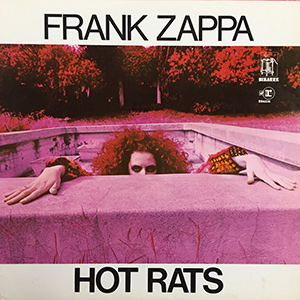
Frank Zappa’s classic, highly regarded, 1969 jazz/fusion outing. It was also one of the first albums to make use of 16-track recording using a custom-built machine. The VM760SLC was quite at home with this material and it made the album sound very lively overall. There is a lot going on in the song “The Gumbo Variations.”
Extended (and heavily processed) guitar, saxophone and violin solos, with multiple drum and horn overdubs. And yet the Audio-Technica cartridge was quite adept at revealing all the details and nuance within the complex arrangement. A few of the highest, intentionally squeaky, sax notes made me wince a little, but otherwise this was a great sounding track with this cart. “Little Umbrellas” has such a thick, deep and punchy bass line running right through it and the VM760 SLC did a great job revealing the depth of tone of the notes without burying the string detail and decay from the plucking. Captain Beefheart’s vocals sounded properly mangey on the track “Willie the Pimp”. They had an unusual separation to them as if they were copied to two separate tracks, but they sounded as they should for the tune. The myriad of oddball percussion instruments that periodically popped up in either channel sounded especially clean and clear. They seemed notably unmolested from the studio processing that everything else in the track got. Kudos to the VM760SLC for making that apparent.
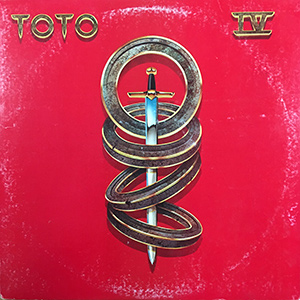
A slick, well-produced pop-rock album from a band made up of seasoned session players. Toto IV was the album that cemented Toto’s popularity worldwide from that point on. The VM760SLC handles this material very well for the most part.
The album’s two most well-known tracks “Rosanna” and “Africa” sounded as clean as good vinyl could possibly sound with excellent separation of the instruments and full sounding vocals, set pretty much dead center. Bass, guitar and keyboards all sounded as good as they should through this cartridge. But, as well recorded as this music was, the thing that instead caught my attention was the harshness of the cymbals while I was listening with the Paradigm speakers. They sounded too thin and grainy compared to how well the rest of the album sounded. I didn’t get a chance to listen to this album through my Bamberg/subwoofer combination in order to observe any differences. I did, however, swap out the VM760SLC for the VM540ML and then with my reference AT OC9ML/II. Sure enough, the cymbals on these tracks sounded much better to me and were devoid of any harshness with the latter two carts in place.
Bench test analysis by David A. Rich and Carlo Lo Raso.
Benchmarks were obtained by using a Technics SL1200 Mk 6 turntable, which has been modified and rewired by KAB Electroacoustics, as a testbed. The CBS Technical Labs (STR 100) test LP was used for frequency response and distortion at the standard recording level of 5um/ sec groove velocity. The CBS Technical Labs (STR 112) test LP was used for high level THD and two-tone intermodulation distortion tests. Three tone intermodulation distortion tests were performed using the Shure TTR 117 LP. A CBS Technical Labs (STR 170) test LP is used for measuring lateral (mono) frequency response.
The output, from the phono stage, was recorded digitally at 24-bit 48 kHz (to minimize groove wear on the test LPs) on a TASCAM HD-P2 digital recorder. Those results were analyzed on my computer using SpectraPLUS audio measurement software via the Lynx TWO B professional sound card. The Rotel RQ-970BX phono preamp was used for all these tests. Since the VM540ML review, we have changed phono preamps to the Rotel RQ-970BX which has a flatter frequency response and a high immunity from being overloaded with test signals from some of the more aggressive LP grooves.
It is best to consider this a supplement to the VM540ML review. That review had a sidebar on stylus shapes which are the single difference between the VM540ML and VM760SLC that should affect the measurements. Because the VM760SLC has a “Special” Line Contact stylus, I do repeat some of that material below.
The VM7XX series transitions from the VM5XX plastic case to a metal one. In the past, this transition has signified a whole new cartridge. For example, the last generation metal case AT150ML substituted a boron cantilever for the aluminum in the plastic AT440ML. The generator was also different. The specification sheet for the AT440ML and AT150ML cartridges indicate different internal inductance and winding resistance. This is not the situation with the VM cartridges. All the specs outside the stylus shape are the same.
The frequency response tests are made with CBS STR 100 LP using the spot frequency response test grooves for the left and right channels. These are at a reference level velocity of 5cm/sec above 1kHz. The velocity is reduced below 1kHz to keep the groove width well within the tracking ability of any modern cartridge. This test LP was used continuously in Stereo Review Magazine. It was often used in Audio Magazine and High Fidelity, although in the 80s they moved to other test LPs. The changes in test LPs showed little difference between the results for a given cartridge with the STR 100 in Stereo Review and the alternative LPs used in the other magazines. In practice, our results closely correlate to the results in all three benchmark magazines when we’ve had access to a cartridge they tested at the time, specifically the Shure V15 type V MR.
Ignore the channel separation below 100Hz. Below 100Hz turntable rumble, groove noise and AC hum spurs exceeds the crosstalk level.
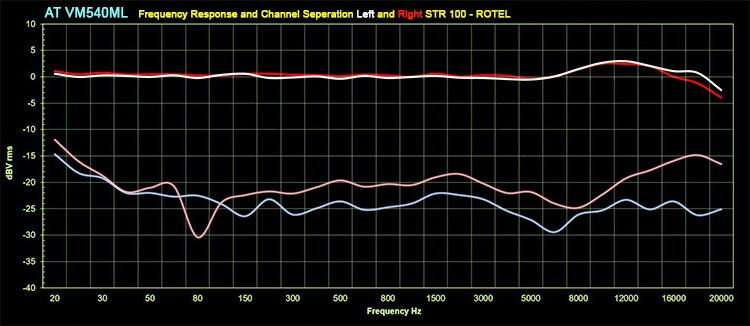
VM540ML Frequency Response and Crosstalk
The VM540ML is very flat to 7kHz. Both channels are confined to less than a dB variation from 25Hz to 6kHz. Then it starts a slow rise up with a maximum value of 3dB at 10kHz for the worst-case right channel. The 10kHz bump is at 2.5dB for both channels. The bump sticks around a little longer in the left channel. The right is almost at 0dB at 16kHz and the left is at +1dB. At 18kHz the response turns down finally ending up with at -4dB at 20kHz in the worst-case right channel.
This bump shows up to varying degrees in all high output Audio-Technica moving magnet cartridges with the VM5XX and VM7XX body style. The frequency response of the VM540ML is about the flattest Audio Technica measurement we know of to date, looking at almost all of what we judged to be reliable test reports across time. This goes back to the AT-155LC cartridge (High Fidelity Magazine March 1981). The AT-155LC was the first Audio Technica cart with the metal body style although the stylus, cantilever and generator are not the same as in the VM series.
The bump from 8kHz to 16kHz, followed by the drop at 20KHz, occurs in these Audio-Technica cartridges when they are terminated with the typical 250pf phono preamp/cable capacitance loading combination. Audio-Technica specifies 100pf optimum but this is almost impossible to achieve, unless the cables are very short, and the phono preamp has less than the typical 100pf loading alone. The cause of this frequency bump is an interaction between the L (inductance) and R (resistance) values of the fixed coils in the cartridge body interacting with the external parallel C (capacitance) of the cables and preamp input. This interaction can be reduced by decreasing the output voltage which in turn reduces L. A cartridge with a distinctly different design, the Signet/Audio-Technica TK 10ML, was designed with the output reduced by a factor of two. The frequency response of the TK 10ML was flat past 20kHz (Audio Magazine February 1985 and. High Fidelity Magazine March 1984).
Secrets Sponsor
Moving Coil cartridges have significantly smaller L and, as a result, much lower output. This is the case for the Audio-Technica OC9II/ML, which we have just tested. Initial indications show the frequency response of the OC9II/ML to be even flatter than the cartridges discussed in this review. That is not to say all moving coil cartridges are flat, but well-designed ones like the OC9II/ML will be so. Distortion performance of the OC9II/ML is only slightly outside the best moving magnets. The added mass of the coils, at least in this cartridge, does not appear to make a significant difference until you hit 10kHz. The key feature, relative to other MC cartridges, is the presence of the Micro Line stylus.
The case for the moving magnet cartridge is that they are about half the price of an equivalent moving coil. The stylus is replaceable and, most important, removable when the cartridge is installed. This has become even more significant with some of the wacky new tonearm designs which do not have removable head shells.
The stylus assembly of the VM series fits in the VM5XX and VM7XX bodies. We took the stylus of the VM540ML and moved it to the VM7XX body. The result is a VM740ML
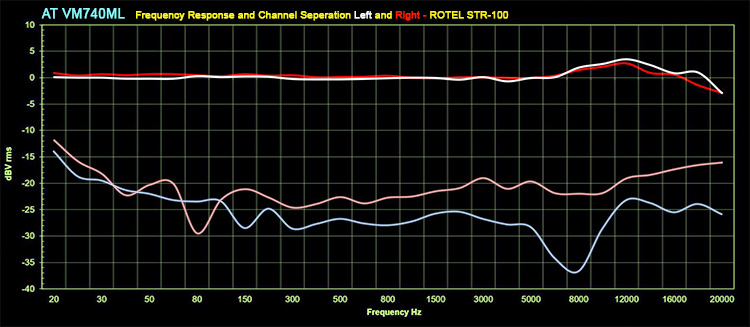
VM740ML Frequency Response and Crosstalk
While we should not see any difference given the specifications for the cartridges are the same the bump now pushes up to +4dB in the worst case left channel. It is unclear if this is just manufacturing tolerance or added stray parasitic L and C from the metal body.
We note the mass of the metal body is significantly higher than the plastic body which lowers the low frequency arm- cartridge resonance, but that occurs below 20Hz. Our measurements are done with a silicon damper on the pivot side of the tone arm to minimize this.
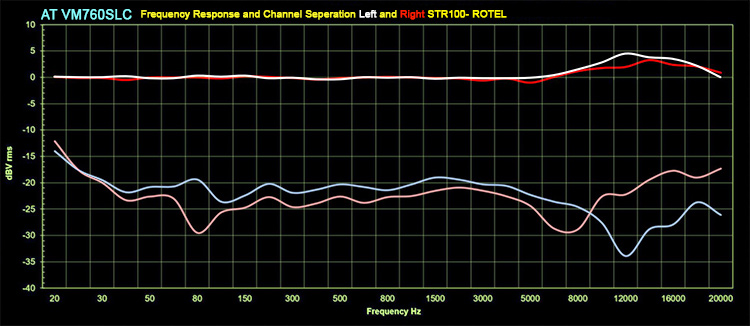
VM760SLC Frequency Response and Crosstalk
Switching out the Micro Line Stylus for the Special Line Contact creates a VM760SLC. The right channel looks similar but the peak in the left channel is now at 4.5dB and 3.3dB in the right channel. The high end returns to flat at 20kHz in the left channel and is up 1dB in the right channel. We do not see the same roll-off that occurred between 16kHz and 20kHz in the VM540ML and VM740ML here. That behavior looks to have been pushed out beyond 20kHz. Some of this may be due to the change from ML to SLC stylus shapes.
The worst-case channel separation has improved slightly above 12kHz compared to the VM540ML and VM740ML in the worst-case channel.
From the measurements above, the VM540ML (the cheapest of the units we examined) has the smallest bump at the cost of some high frequency loss at 20kHz. Subjective response to the bumps in the 3 cartridges was presented earlier in the review.
The main difference between the Audio-Technica VM760SLC and VM540ML is the stylus. The other change, in body material, from plastic to metal was addressed above.
The Line Contact design was the first advance in stylus shape over the elliptical stylus for stereo records. Another different stylus shape was developed for use with RCA Quadraphonic LPs and RCA SelectaVision NTSC video LPs. Unfortunately, it had disadvantages when playing regular stereo LPs. Later the advanced Micro Line Stylus appeared along with another different design called the Van Den Hull. All of these designs have patents associated with them.
Below we have listed the major and minor radius figures for an elliptical stylus, the Audio-Technica Special Line Contact stylus and the Micro Line stylus. In specification sheets, early stylus shapes tend to be reported in 1000th of an inch (mil) while later shapes use metric, in microns (um). In addition, the minor radius figures used to be reported first for the early elliptical styli but, for modern shapes, they flipped to reporting major radius first. Audio-Technica does not use the Van Den Hull design.
In the table below, we kept the older convention of minor radius first and have also included English and Metric values.
| English Units (mil) | Metric Unit (um) | |
| Elliptical: | 0.3mil*0.7mil | 7.6uM*17.8uM |
| Line Contact: | 0.28mil*1.57mil | 7uM*40uM |
| Micro Line: | 0.098 mil*2.95mil | 2.5uM*75uM |
The elliptical stylus shape was developed by Joe Grado in the 1960s and the patent has long since expired. It is relatively simple to turn a conical cartridge into an elliptical. You make two cuts on the diamond, first at the front and then the back. The Line Contact stylus, specific for stereo records, was developed in the mid-70s. The Micro Line was developed by Shimamoto of Namiki Precision Jewel Company in the early-80s and is patented. The manufacturing process for the Micro Line is more complex than the Line Contact, disclosed in the patent. Both stylus shapes need grinding and polishing compared to the elliptical which are two chops of a blade.
A specific patent for the Fine Line stylus shape does not appear to exist. Multiple companies have produced it using different methods. The Micro Line was adapted by both Shure and Audio-Technica as soon as it came out. Unfortunately, for cartridge manufactures, the early-80s marked the arrival of the CD which brought with it the accompanying large drop in phono cartridge demand. Some companies just froze the lineup with the Fine Line design. A competitor stylus to the Micro Line design was developed by Van Den Hull. That stylus goes by many different names besides its inventor’s, with Gyger being the most common alternate name. Ortofon decided to go the Van Den Hull route although I do not know when they made the switch.
Audio-Technica has produced a diagram of the 3 stylus shapes they use, in cross section. The key attributes of the stylus are at the bottom of this diagram.

D1 is the horizontal contact length. The vertical contact length (D2) sets how small of a groove the stylus can fit in. The values of D1 and D2 are related to, but are smaller than, the major (R) and minor radius (r) of the stylus. The relationship is non-linear, so the change in value between the R and D1 (r and D2), differs between stylus shapes. The Contact Area represents how much of the stylus contacts the groove. A simple value of the area would be D1 * D2. That is an overestimate since the real contact patch is oval shaped and not a box as shown in the figure.
We want a big stylus contact area so that the force on the stylus can be distributed over a larger surface area. The contact area of an elliptical, as provide by some older Audio-Technica literature, is 23.4um2 while the Micro Line was specified as 62.5um2. Unfortunately, Audio Technica dropped the surface area specification from their latest literature so I do not have the requisite number for the Special Line Contact stylus.
Audio Technica specifies the vertical contact width (D2) for the 0.3um (7.6um) elliptical stylus to be 4um. The Micro Line stylus is a smaller 3.5um. The difference is not as big as might be expected. Again, Audio-Technica has not published the value of D2 for the Special Line Contact. The issue with an elliptical stylus is that it has such a small contact area, so it basically pushes in the small high frequency vinyl grooves and causes distortion. It’s unclear if the vinyl ever recovers from this or the high frequencies just get worn down over time. The good news is that a stylus with a long D1 sees more of the surface allowing it to see small grooves that the elliptical may have partially erased.
In measurements performed by audio magazines publishing in the 70s and 80s, the data showed that distortion levels declined for Audio-Technica and Shure cartridges that used the Micro Line stylus in comparison to cartridges in the 70s that used line contact.
With the Special Line Contact on the VM760SLC, Audio-Technica appears to be time-travelling from the early-80s to the mid-70s. If the stylus is indeed “Special” we should see the distortion of the VM760SLC decline relative to the Micro Line (VM540ML). As stated several times above I am missing D1, D2 and the contact area figure of this stylus.
In our testing, we repeated all the distortion measurements, using the VM760SLC, which we performed in our VM540ML review. All the distortion measurements were taken with a VTF of 2.0 grams. The resulting data was compiled in the chart below:
The results show an increase in single tone distortion with the VM760SLC at higher frequencies moving up by a factor of two past 2kHz. If this Line Contact stylus is in some way special, it is not showing up in the data.
In the low frequency wide groove tests, we saw no difference. At low frequencies, the stylus shape is not what dominates. The compliance of the cartridge is important, and it is set by the cantilever design, the rubber assembly design which holds the cantilever in place, and the attachment system for the magnet. Both cartridges turn in excellent results. Other designs do not do as well as these carriages.
In the 400Hz – 4kHz IM test, where the 400Hz groove plays at significantly higher levels than the 4kHz tone (level difference shown in chart) only the 400Hz varies in level between the tests. For the IM tests with the 400Hz tone at its lowest value, both cartridges produce similar results in the vertical and lateral modulated grooves. Increasing the level of the 400Hz tone by 12dB in the lateral IM test shows the VM760SLC turning in a surprisingly better IM than the VM540ML. Things are back to expectation in the vertical modulation test, with the 400Hz tone up 6dB. The ML stylus produced 1/3 the distortion level of the SLC.
Using the Shure TTR117 test LP’s triple IM tests (level 6), the 2.1kHz level approaches 11cm/sec. The greater than 2X difference between SLC and ML returns for the 2.1kHz THD and 2kHz / 17kHz IM. Surprisingly this is not the case for the 200Hz / 2kHz IM which are matched in the less difficult level 1 test. Both here and at level 6, the VM760SLC turns in the better performance.
For those of you who have not had enough of distortion measurements, we present the spectra. This is only for the real cartridge geeks. The table gave us the information we needed to know with respect to the performance of the SLC and ML stylus shapes.
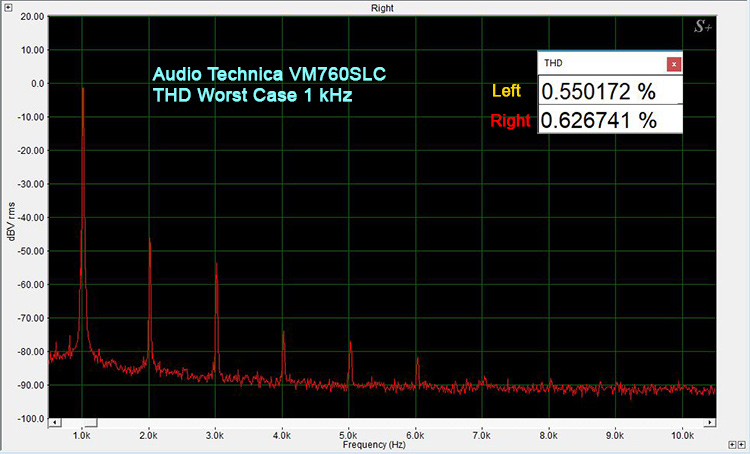
VM760SLC THD Worst Case Right Cannel @ 1kHz
As can be seen the worst-case distortion is slightly above 0.6% at 1kHz.

VM760SLC THD Worst Case Left Cannel @ 5kHz
The left channel also produced the worst-case distortion at 4.3% at 5kHz. The VM540ML achieved a 2.0% distortion figure.
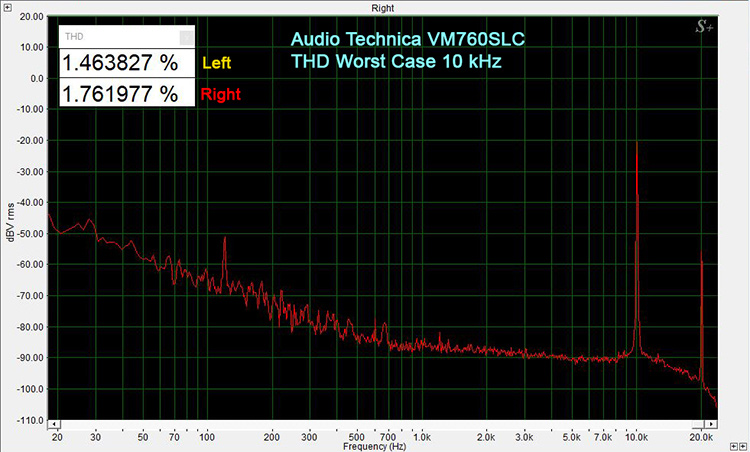
VM760SLC THD Worst Case Right Cannel @ 10kHz
Distortion at 10kHz takes into account only the 2nd harmonic but that is the dominant one. The worst-case value is THD 1.76% with the VM540ML producing 0.9%
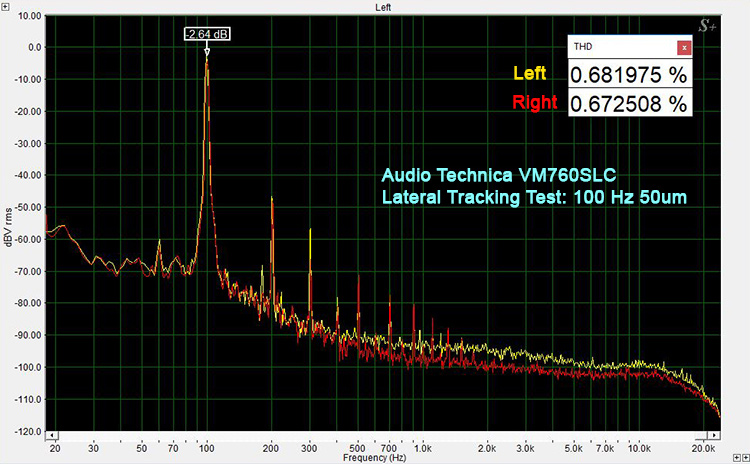
VM760SLC Lateral Tracking Test: 100Hz 50um
Above is the spectrum of 100Hz lateral groove at 50um. The worst case THD is 0.68%. The dominate harmonics are the 2nd and 3rd. The VM540ML comes in slightly higher at 0.8%.
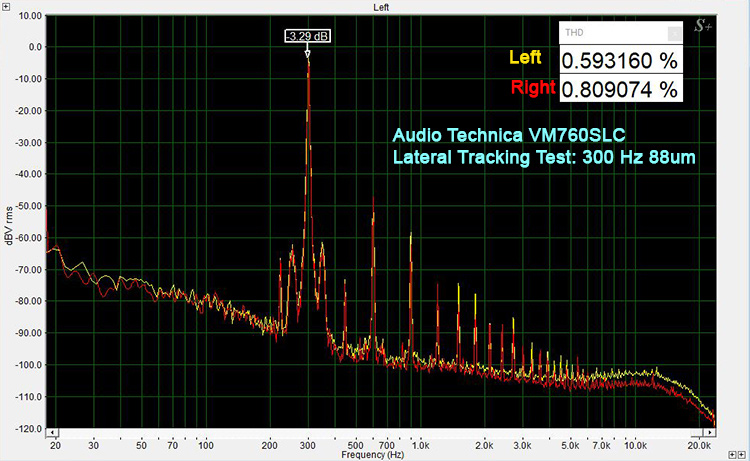
VM760SLC Lateral Tracking Test: 300Hz 88um
This spectrum is a 300Hz lateral groove at 88um. The THD value is 0.8% in the worst-case channel. You see additional higher order harmonics have increased with the increasing groove size and frequency. Again, this is a little better than the VM540ML which produced 1.1%.
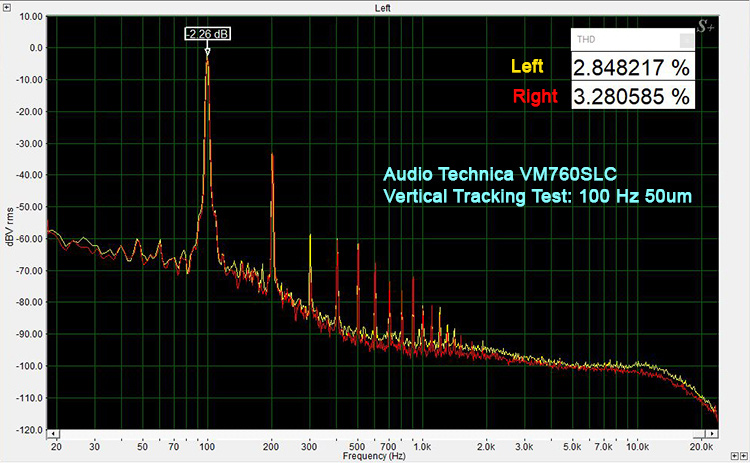
VM760SLC Vertical Tracking Test: 100Hz 50um
Above is the rarely reported distortion in the vertical direction. For a 50um groove at 100Hz, the distortion is 3.3% which is more than 4 times the lateral result. Vertical distortion differences from lateral are a secret cartridge manufacturers would not like you to see. The mechanics of moving up and down are different from side to side. Again, the VM540ML comes in a tad higher at 3.9% worst-case.
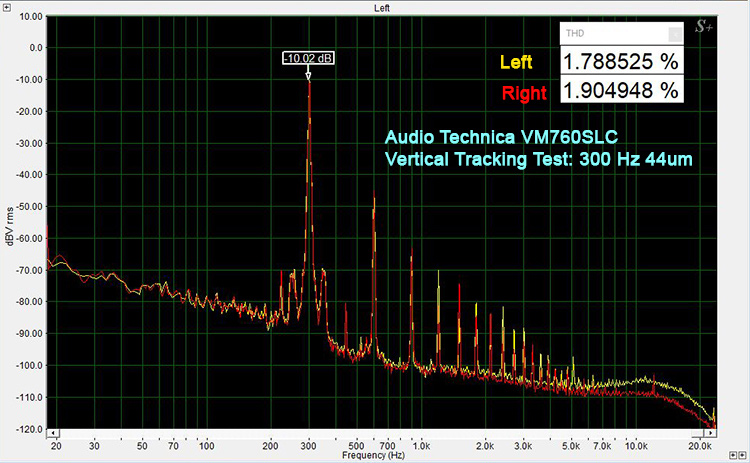
VM760SLC Vertical Tracking Test: 300Hz 44um
Here is a 300Hz vertical spectrum for a groove 44um long. At 1.9%, this is double the lateral. Note the significant number of harmonics all the way out to 5kHz. Again, this is a little better result the VM540ML which did 2.8% worst-case.

VM760SLC Lateral IM Test: 400Hz 22um
The large grooves now move from 100Hz and 300Hz to 400Hz and we add a 4kHz tone set at 2.5 cm/sec which will produce a tone at -6dB below the tests used for the 1kHz – 10kHz THD tests above (pre-RIAA EQ).
The spectra above are a 22um groove at 400Hz. THD at 400Hz is 0.6% which is a little better than the VM540ML. 4kHz is at 0.8% for both cartridges which is a surprise.
The presence of the two tones affects the THD each produces. It will be larger than if they were in isolation as shown above and in the chart.
The IM spurs are at 3.2kHz, 3.6kHz, 4.4kHz and 4.8kHz. You cannot just add the individual IM spur levels (converted for dB to absolute level) to create the total IM distortion level. Instead each tone level is squared and added to the other squared values. The square root is taken of the result. This is an RMS summation. I then divide by the fundamental level to produce the distortion level.
Note the 400Hz tone is 20.4dB higher than the 4kHz which is approximately 10 to 1. Which tone level should be used as the fundamental in the calculation? Typically, the answer is the higher-level tone. Using that, IM distortion is 0.8% up from 0.63% for the VM540ML.
Now let’s use the smaller 4kHz as the reference. The IM jumps up to 8.0%. The IM value change reflects the difference in the tone levels. See the chart above for the level difference for each IM test.
Which is the number reflective of how the cartridge sounds? We must make a subjective evaluation. How do we do this? We have to listen to the sound of the groove directly. The large 400Hz tone makes the IM around the smaller 4kHz tone harder to hear. Put a 1kHz filter before the speakers and the 400Hz tone drops out. Now the IM distortion is much more apparent.
Filtering out the louder 400Hz tone allowed me to hear the resulting IM Distortion at 4kHz. No longer was it a pure sounding tone but it was now a tone with a noticeable buzzing sound to it. While doubtful that this would be heard in normal music listening, it might become more of an issue with loud and complex orchestral arrangements. It does also demonstrate obvious limitations in the vinyl format. Namely, where lower frequency content can cause audible distortions in higher frequency content in regular playback.
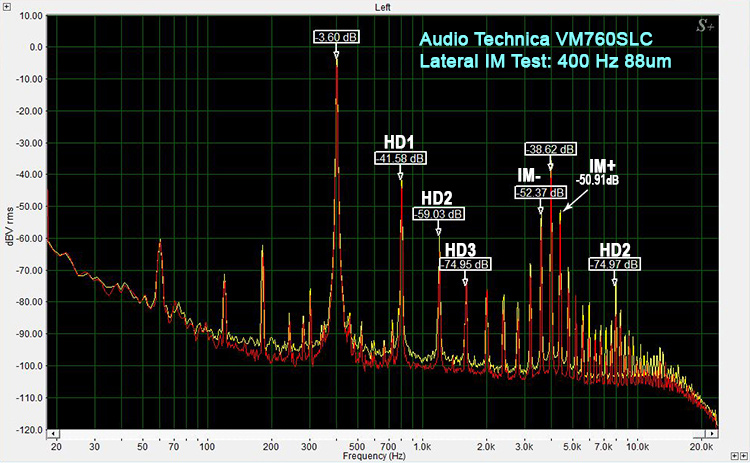
VM760SLC Lateral IM Test: 400Hz 88um
Moving up to a hurricane sized groove of 88um lateral which is 12dB higher than the last spectrum, what happens to our little 4kHz groove at constant level?
First note the 4kHz tone level, which should be constant, is down from -35.8dB to -38.6dB. The energy that should be in the 4kHz tone is spreading to the IM sidebands.
Calculating the IM relative to using the very large 400Hz tone as a level reference, the IM is small at 0.3% which is better than the ML at 0.44%. The 400Hz THD is a slight win for the SLC at 1.2% and surprise the THD for the SLC, at 4kHz, is 0.7% down from 1% for the ML.
Re-referencing the IM to the 4kHz tone produces much bigger IM numbers. It goes up to 17% for the SLC. Nothing has changed but the reference. By zeroing in on the 4kHz signal and filtering out the 400Hz tone, it becomes clear that the 4kHz is significantly distorted.
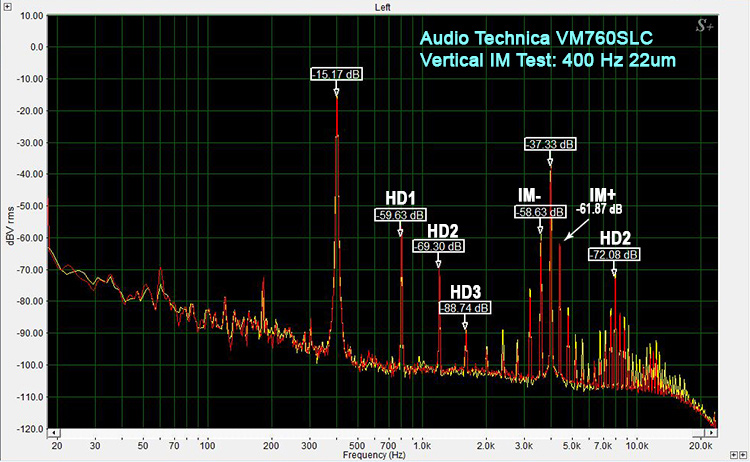
VM760SLC Vertical IM Test: 400Hz 22um
This is a 22um vertical groove test for 400Hz and with a vertical 4kHz, again at 2.5cm/sec. at 6dB down from our isolated THD tests above. THD at 400Hz is 0.5%, 4kHz for the SLC is up compared to the SLC lateral performance at 1.4%. This value is twice that of the VM540ML. In the lateral grooves the stylus turned in matched performances, but stereo grooves contain both a vertical and lateral component. Lateral is mono.
IM test results, surprisingly, show no change from the lateral results.
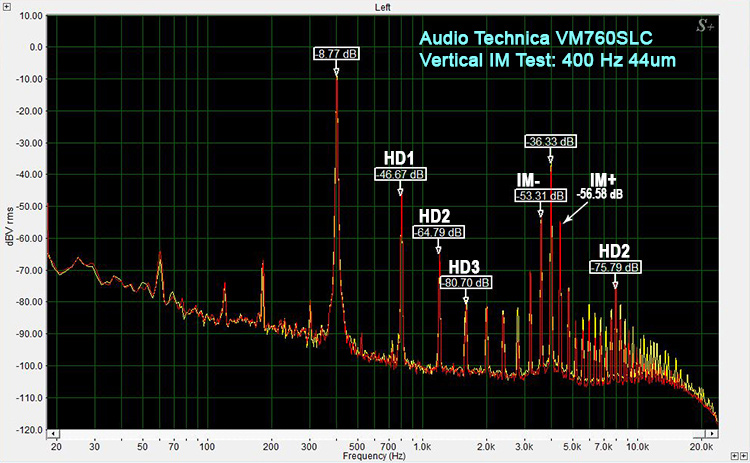
VM760SLC Vertical IM Test: 400Hz 44um
This is a 44um vertical groove test for 400Hz (up 6dB) and the vertical 4kHz groove at the same level as the previous spectra. The 4kHz fundamental has dropped 1dB. The 4kHz THD is now at 2.0% up from 0.65% for the VM540ML. The 400Hz THD are matched at 0.83%. The IM is at 1.56% for the SLC and 1/3 that level, at 0.53%, for the ML.
Again, the IM number can be made to look much larger by referencing to the smaller 4kHz tone.
We move now to the Shure TTR117 trackability test LP.
The LP has 6 levels. They go up 7dB from the lowest (Level 1) to the hottest (Level 6) test. We tested with the Level 1 and Level 6 grooves. Groove velocity of the 200Hz tone is at 1cm/sec, the 2.1kHz tone at 4.9cm / sec and the 17kHz tone at 4.5cm /sec for Level 1. These sizes are about the same level as we used in the THD tests, but the presence of 3 tones on one groove will change the results, and we have additional results for the tone intermodulation spurs.
For Level 6, the groove velocity of the 200Hz tone is at 2.2cm/sec, the 2.1kHz tone at 11cm / sec and the 17kHz tone at 10cm /sec.
We have 4 IM spurs to take account of to create the IM between 200Hz / 2.1kHz. 4 more spurs enter the calculation of the 2.1kHz / 17kHz IM. I have fit all the spur frequencies in the charts as well as how I calculate the total IM spur energy in the table.
Again, we get two IM values for each IM test depending if we reference the lower or higher-level tone in the IM set. These are both shown in the chart. Note in these tests the 2.1kHz tone has the highest level with RIAA EQ. 200Hz is 3dB smaller and 17kHz is 19dB below 2.1kHz. With the middle tone being the largest, the change in IM from low tone reference to high tone reference flips when calculating the 200Hz / 2.1kHz IM compared to the tests above where the high frequency tone was lower in level (400Hz).
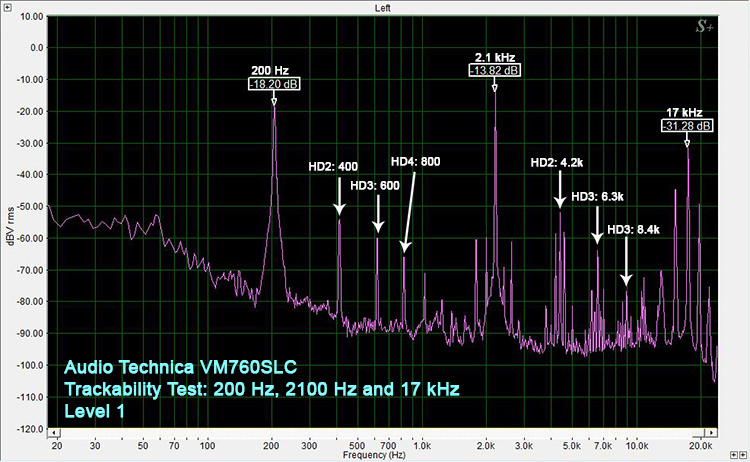
VM760SLC Trackability Test: Level 1
At Level 1, the THD for the 200Hz tone is 1.9% matching the VM540ML. The 2.1kHz THD is at 1.25% with the VM540ML 0.58%.
IM between 200Hz and 2.1kHz is 0.8% again matching the VM540ML. The value is referenced to the larger 2.1kHz tone.
The IM spurs around 17kHz are referenced to the larger 2.1kHz tone. The result is 3.1% for the SLC dropping to 1.5% for the ML.

VM760SLC Trackability Test: Level 6
The last spectra!!!!!!!!!!!!!!!! This is perhaps the most challenging. Shure tried to create one groove to encapsulate tracking performance, but all our tests show a different aspect of the cartridge’s performance.
THD for the 200Hz tone is 1.9% which matches the VM540ML. The 2.1kHz THD is at 2.0% for the SLC with the VM540ML at 0.8%.
IM between 200Hz and 2.1kHz is 0.9% for the SLC. The value is referenced to the larger 2.1kHz tone. For reasons not understood the ML is worse at 1.6%
The IM spurs around 17kHz are referenced to the larger 2.1kHz tone. The result is 4.5% for the SLC dropping to 2.4% for the ML.

VM760SLC in the wild
The VM760SLC is a good cartridge for just the right person. For everyone else, get the VM540ML.
- Good bass and midrange reproduction.
- Interchangeable VM stylus to allow tuning to preference.
- Great build quality.
- Wish it had a Shure-type stabilizer brush.
- A more linear upper end response for my taste.
The Audio-Technica VM760SLC is a good to great sounding cartridge in the right circumstances. It is voiced with a modestly hotter top end so if you like the additional “perceived” detail in your music for example, then this cartridge could work for you. That being said, careful matching to your system and speakers is advised in case that extra “air” turns into edgy sounding treble when paired with the wrong speaker combination. If you are the kind of person who likes to regularly tweak your system or has multiple “flavors” of carts for different music selections, then the VM760SLC could also be a good fit. The interchangeable styli from the entire VM line give you several options to tune the sound to your liking, should you choose. If you are looking for just a single all-around cartridge to play your music, then I would simply stick with the VM540ML. You will get a flexible and more linear reproducer for various kinds of music and you’ll save yourself a few bucks to boot. The VM760SLC is designed to fill a particular niche in the Audio-Technica phono cart line. If that niche is where you happen to find yourself, then you may well want to give this phono cartridge a look.


